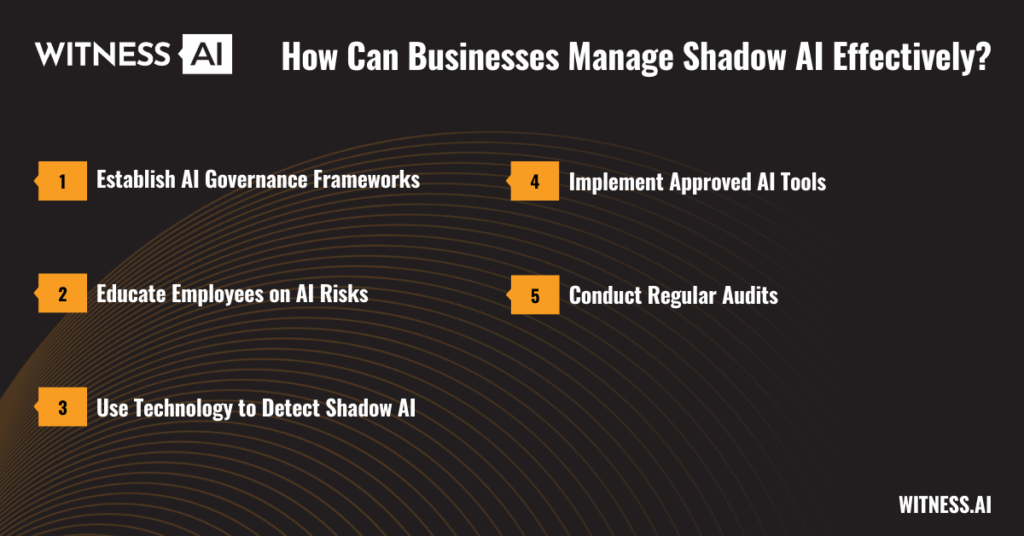What is Shadow AI?
Shadow AI refers to the unsanctioned or unauthorized use of artificial intelligence (AI) tools, applications, or models within an organization—without the knowledge or approval of the IT department or governance bodies. This includes employees using generative AI tools like ChatGPT, OpenAI APIs, or other AI-driven platforms to automate tasks, generate content, or support decision-making without aligning with corporate policies or security protocols.
As AI adoption accelerates, particularly with the rise of large language models (LLMs) and accessible generative AI solutions, shadow AI is becoming a growing concern. These unauthorized AI applications often operate outside formal governance frameworks, making them difficult to track, assess, or secure.
How is Shadow AI Different from Shadow IT?
To fully understand the concept of shadow AI, it’s important to distinguish it from shadow IT—an older but closely related phenomenon.
Shadow IT
Shadow IT occurs when employees deploy unapproved software, hardware, or cloud services—such as personal SaaS tools or file-sharing platforms—without the involvement of the IT department. While often intended to streamline workflows or fill operational gaps, shadow IT introduces significant risks by bypassing established IT safeguards.
Shadow AI
Shadow AI, a subset of shadow IT, specifically involves the use of AI technologies, including generative AI tools, chatbots, or machine learning models, outside formal oversight. This includes employees inputting sensitive data into ChatGPT, using unvetted AI apps for decision support, or deploying external AI services for business automation without IT approval. The key difference lies in the complexity and opacity of AI outputs, which often involve non-deterministic logic and introduce new types of risk beyond traditional software usage.
How Does Shadow AI Occur?
Shadow AI typically emerges in environments where AI enthusiasm outpaces oversight. Employees may turn to AI solutions for productivity gains—summarizing reports, drafting emails, coding scripts, or analyzing datasets—without fully understanding the associated security or compliance risks.
Examples of Shadow AI
- A marketing analyst uses ChatGPT to generate campaign content using customer data.
- A developer integrates a third-party LLM API into a product prototype without IT review.
- An HR manager uses an AI-powered resume screening tool not vetted by legal or compliance teams.
- A sales team employs an AI chatbot to qualify leads, storing prospect data in an unmanaged cloud environment.
These examples reflect how easily AI tools can be integrated into everyday workflows—often under the radar of IT and security teams.
What Are the Risks of Shadow AI?
While shadow AI can offer productivity benefits, it poses significant risks to organizational integrity, compliance, and cybersecurity.
Security Vulnerabilities
Unauthorized AI systems are typically not subject to internal security reviews or updates, making them vulnerable to exploits. LLMs may also introduce novel attack surfaces such as prompt injection or model manipulation, exposing the company to cybersecurity threats.
Data Loss
Shadow AI tools often rely on external servers to process data. Uploading sensitive information—customer data, financial records, or intellectual property—can lead to data leakage and breaches. Without visibility, organizations cannot ensure proper data protection or retention practices.
Regulation Violations
Using unvetted AI tools can lead to non-compliance with data protection regulations such as GDPR, HIPAA, or emerging AI-specific laws like the EU AI Act. Regulatory violations can result in hefty fines and legal exposure.
Reputational Damage
In the event of a data breach, biased output, or misuse of AI-generated content, companies may suffer reputational harm. The lack of responsible AI safeguards in shadow deployments can erode trust with customers, partners, and regulators.
Why Is Shadow AI a Challenge for Organizations?
Shadow AI is difficult to detect because of the decentralized, SaaS-driven nature of modern AI adoption. Tools like ChatGPT or Microsoft Copilot are easily accessible, often requiring only a browser or API key to use. Employees may not even realize that using such tools constitutes a risk, especially in roles that reward initiative and productivity.
Furthermore, AI-generated outputs can be indistinguishable from human-generated ones, making audits and oversight more complex. As AI becomes embedded in business workflows—from drafting documents to supporting real-time decision-making—organizations face mounting difficulty tracking how AI is used, by whom, and with what data.
Can Shadow AI Impact Data Privacy?
Yes—shadow AI has direct and significant implications for data privacy. Inputting personally identifiable information (PII), health records, or proprietary datasets into generative AI systems may violate internal privacy policies or external compliance mandates. Many AI platforms store interaction histories, making it possible for sensitive information to be retained or used for model training, unless explicitly opted out.
This risk is especially pronounced when employees use free-tier or trial-based AI services not designed with enterprise-grade privacy protections. Without enforceable data usage controls, shadow AI can unintentionally expose customer data or internal records to third parties.

How Can Businesses Manage Shadow AI Effectively?
Proactive management of shadow AI starts with visibility, governance, and education. Organizations must balance innovation with safeguards that ensure responsible AI usage.
1. Establish AI Governance Frameworks
Create policies that clearly define acceptable AI usage, data handling rules, and approval workflows for new tools. Governance frameworks should cover both technical and ethical aspects of AI adoption, supported by oversight from IT, legal, and compliance teams.
2. Educate Employees on AI Risks
Many instances of shadow AI stem from good intentions—employees trying to streamline work or enhance productivity. Regular training can help staff understand the risks of unauthorized AI usage, including data privacy concerns, security risks, and compliance violations.
3. Use Technology to Detect Shadow AI
Employ network monitoring tools, CASBs (Cloud Access Security Brokers), and AI observability solutions to detect and flag unauthorized AI activity. Look for signs of high-volume API access, unsanctioned use of LLM platforms, or abnormal data transfers. Real-time monitoring can alert security teams to potential data leaks or compliance violations.
Free Tool: WitnessAI Spotlight | Shadow AI Discovery Tool
4. Implement Approved AI Tools
Offer employees vetted, secure alternatives that meet governance and data protection standards. When sanctioned tools are easily available and integrated into workflows, there’s less incentive for employees to seek external options.
5. Conduct Regular Audits
Review AI usage logs, conduct audits of SaaS platforms, and assess shadow AI trends within departments. These audits can identify gaps in policy adherence and help refine detection mechanisms over time.
Final Thoughts
Shadow AI is the modern evolution of shadow IT—driven by the widespread availability of powerful generative AI tools and the urgency to streamline work through automation. While the benefits of AI adoption are clear, so too are the significant risks of uncontrolled, unauthorized use. From data privacy breaches to compliance failures, shadow AI threatens the foundations of responsible AI deployment.
Enterprises must recognize shadow AI as a strategic security and governance issue. With the right mix of visibility, education, technology, and governance frameworks, organizations can harness the power of AI while protecting sensitive data, ensuring compliance, and upholding trust in AI systems.
About WitnessAI
WitnessAI enables safe and effective adoption of enterprise AI, through security and governance guardrails for public and private LLMs. The WitnessAI Secure AI Enablement Platform provides visibility of employee AI use, control of that use via AI-oriented policy, and protection of that use via data and topic security. Learn more at witness.ai.
